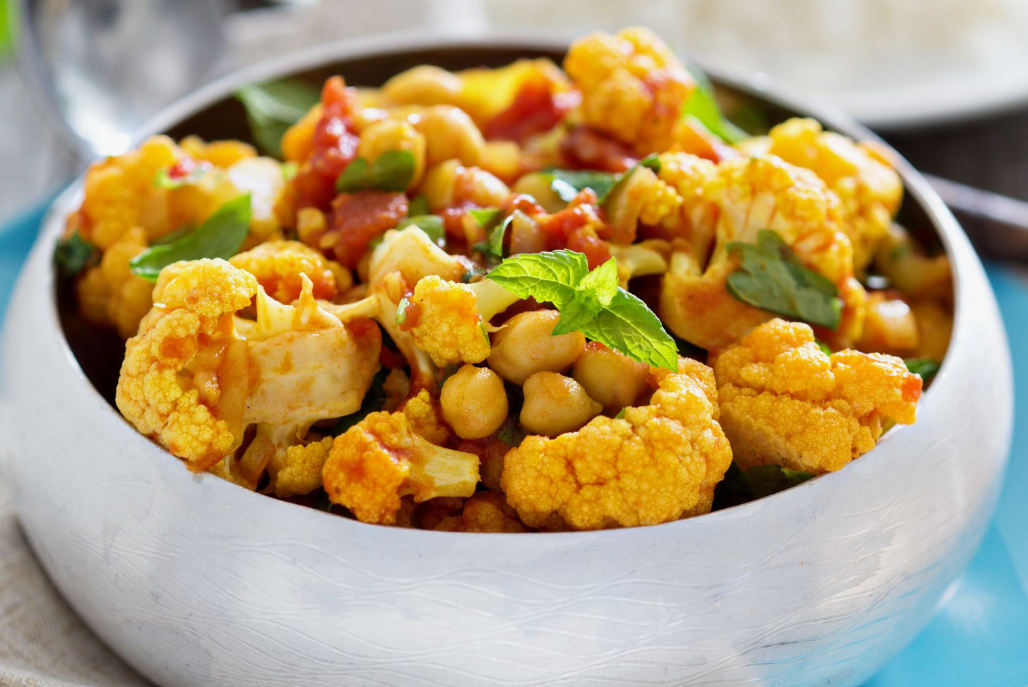
Introduction: Indulge your taste buds in a symphony of flavors with this delectable Coconut Curry infused with the richness of chickpeas and a medley of vegetables. Perfect for a cozy night in or a vibrant gathering with friends, this dish is not only a treat for the palate but also a wholesome meal packed with nutrients. With a harmonious blend of spices and the creamy goodness of coconut milk, this curry promises to elevate your culinary experience to new heights. Let’s delve into the ingredients and instructions to create this culinary masterpiece.
Ingredients:
- 1 tablespoon coconut oil
- 1 onion, diced
- 3 cloves garlic, minced
- 1 tablespoon ginger, minced
- 1 red bell pepper, sliced
- 1 yellow bell pepper, sliced
- 1 cup cauliflower florets
- 1 cup broccoli florets
- 1 can (15 ounces) chickpeas, drained and rinsed
- 1 can (14 ounces) coconut milk
- 2 tablespoons red curry paste
- 1 tablespoon soy sauce (or tamari for gluten-free option)
- 1 tablespoon maple syrup (optional, for a touch of sweetness)
- Salt and pepper to taste
- Fresh cilantro, chopped (for garnish)
- Cooked rice or naan bread (for serving)
Instructions:
- Heat coconut oil in a large skillet or pan over medium heat. Add diced onions and sauté until translucent, about 3-4 minutes.
- Stir in minced garlic and ginger, cooking for another minute until fragrant.
- Add sliced red and yellow bell peppers, cauliflower florets, and broccoli florets to the skillet. Cook for 5-6 minutes, stirring occasionally, until the vegetables begin to soften.
- Incorporate drained and rinsed chickpeas into the skillet, mixing well with the vegetables.
- In a separate bowl, whisk together coconut milk, red curry paste, soy sauce (or tamari), and maple syrup (if using) until well combined.
- Pour the coconut milk mixture over the vegetables and chickpeas in the skillet. Stir gently to coat all the ingredients evenly.
- Bring the curry to a simmer, then reduce the heat to low. Let it simmer gently for 10-15 minutes, allowing the flavors to meld together and the vegetables to cook through.
- Season with salt and pepper to taste, adjusting the flavors as needed.
- Once the curry reaches your desired consistency and the vegetables are tender, remove it from the heat.
- Serve the coconut curry hot, garnished with fresh chopped cilantro. Accompany with cooked rice or warm naan bread for a complete and satisfying meal.
Enjoy the aromatic blend of spices and the creamy texture of coconut milk in this Coconut Curry with Chickpeas and Vegetables, a dish that’s sure to delight your senses and leave you craving for more.
Serving Tips:
- Garnish Creatively: Sprinkle some toasted coconut flakes or crushed peanuts on top of the curry for added texture and flavor.
- Add Freshness: Squeeze a bit of lime juice over the curry just before serving to brighten up the flavors.
- Herbal Touch: Serve with a side of fresh herbs like Thai basil or mint for an extra burst of freshness.
- Customize with Condiments: Offer condiments like sriracha sauce or chili flakes on the side for those who prefer an extra kick of heat.
- Pairing Perfection: Pair the coconut curry with steamed jasmine rice, quinoa, or your favorite type of naan bread for a satisfying meal.
Storage Tips:
- Cool Completely: Allow the curry to cool down to room temperature before storing to prevent condensation and moisture buildup.
- Portioning: Divide leftovers into individual serving-sized containers for easier reheating and portion control.
- Refrigeration: Store the curry in airtight containers in the refrigerator for up to 3-4 days.
- Freezing Option: If you’re not planning to consume the curry within a few days, portion it into freezer-safe containers and store in the freezer for up to 2-3 months.
- Reheating: When ready to enjoy, reheat the curry gently on the stovetop over low to medium heat or in the microwave, adding a splash of water or coconut milk if needed to maintain the desired consistency. Stir occasionally to ensure even heating.
By following these serving and storage tips, you can enhance the dining experience and ensure the longevity of your delicious Coconut Curry with Chickpeas and Vegetables.
Variations:
- Protein Power: Experiment with different protein sources such as tofu, seitan, or tempeh instead of chickpeas for a plant-based twist. Alternatively, add cooked chicken, shrimp, or fish for a non-vegetarian option.
- Seasonal Selection: Swap out the vegetables based on what’s in season or your personal preferences. Consider using zucchini, sweet potatoes, green beans, or spinach for a variety of flavors and textures.
- Spice It Up: Adjust the level of spiciness by increasing or decreasing the amount of red curry paste, or try using green curry paste for a different flavor profile. For an extra kick, add sliced fresh chili peppers or a pinch of cayenne pepper.
- Nutty Nutrients: Incorporate a handful of cashews or almonds into the curry for added crunch and nutritional benefits.
- Creamy Coconut Options: Experiment with different types of coconut milk such as light coconut milk for a lighter version, or coconut cream for an extra rich and creamy texture.
- Asian Fusion: Add a touch of Asian flair by incorporating ingredients like lemongrass, galangal, or kaffir lime leaves for an aromatic twist.
- Indian Influence: Infuse the curry with Indian spices like garam masala, turmeric, and cumin for a fragrant and flavorful Indian-inspired variation.
- Citrus Sensation: Enhance the curry with the zest and juice of an orange or lemon for a refreshing citrusy twist.
- Coconutty Cauliflower Rice: Serve the curry over cauliflower rice instead of traditional rice for a low-carb, keto-friendly option.
- Creamy Coconut Soup: Thin out the curry with vegetable broth or coconut water to transform it into a luscious coconut soup, perfect for sipping on a chilly day.
Get creative in the kitchen and explore these variations to customize your Coconut Curry with Chickpeas and Vegetables according to your taste preferences and dietary needs.
FAQs:
- Is this dish spicy? The spiciness level can be adjusted according to personal preference by varying the amount of red curry paste used. Feel free to add more or less to suit your taste.
- Can I make this curry ahead of time? Yes, this curry can be made ahead of time and stored in the refrigerator for 3-4 days or frozen for longer storage. Just reheat gently before serving.
- Is coconut milk necessary, or can I use another type of milk? Coconut milk adds a rich and creamy texture to the curry and contributes to its distinctive flavor. However, you can substitute with other types of milk such as almond milk or cashew milk, but keep in mind that the flavor and consistency may vary.
- Can I omit the chickpeas or replace them with another ingredient? Yes, you can omit the chickpeas or replace them with another legume such as lentils or beans. Alternatively, you can add extra vegetables or protein of your choice.
- Is this dish gluten-free? Yes, this coconut curry is naturally gluten-free. Just ensure that the soy sauce or tamari used is labeled gluten-free if you have dietary restrictions.
- Can I make this curry without oil? Yes, you can make this curry without oil by using a non-stick pan or by sautéing the vegetables in a small amount of water or vegetable broth instead.
- How do I make this curry less spicy? To make the curry less spicy, reduce the amount of red curry paste used or omit the fresh chili peppers. You can also add a squeeze of lime juice or a dollop of coconut yogurt to mellow out the heat.
- What can I serve with this coconut curry? This coconut curry pairs well with cooked rice, quinoa, or naan bread. You can also serve it alongside a fresh salad or steamed vegetables for a complete meal.
- Can I freeze leftovers? Yes, you can freeze leftovers of this coconut curry for up to 2-3 months. Just portion it into freezer-safe containers and thaw in the refrigerator before reheating.
- How can I make this curry more flavorful? To enhance the flavor of the curry, you can add additional spices such as cumin, coriander, or cinnamon. You can also sauté the aromatics (onion, garlic, and ginger) for a few extra minutes to deepen their flavor.
Conclusion:
In conclusion, Coconut Curry with Chickpeas and Vegetables offers a delightful culinary journey filled with vibrant flavors and wholesome ingredients. Whether you’re a seasoned chef or a novice in the kitchen, this versatile dish is sure to satisfy your cravings and impress your taste buds.
With its creamy coconut milk base, aromatic spices, and a colorful array of vegetables, this curry embodies the perfect balance of indulgence and nutrition. From the comforting warmth of each spoonful to the satisfying crunch of every vegetable bite, every aspect of this dish is designed to tantalize your senses and leave you craving for more.
By following the simple instructions provided and exploring the various serving suggestions, storage tips, variations, and FAQs, you have the flexibility to tailor this recipe to your liking and dietary preferences. Whether you’re looking for a quick weeknight meal, a crowd-pleasing party dish, or a flavorful addition to your culinary repertoire, Coconut Curry with Chickpeas and Vegetables is the perfect choice.
